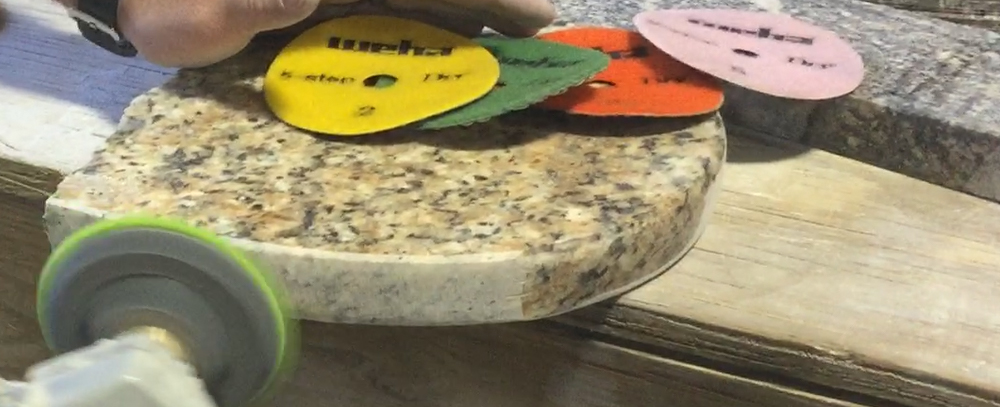Wet Polishing and Dry Polishing, A Comparison
A fundamental question that is considered among many stone fabrication professionals and novices alike can be boiled down to the following inquiry, “Should I use wet polishing techniques or dry polishing techniques?” That is a good question. And the answer may surprise you.

Diversity in Stone Polishing
To answer the question of whether to use dry polishing or wet, it is good to briefly examine some of the similarities and differences between the two methods and then discuss why each method might be chosen.
Wet and Dry Polishing Similarities
When it comes to the actual task of polishing stone. There are many similarities between wet polishing and dry polishing. We will consider a couple of these parallels here.
The Tools
The tools used to perform polishing on granite, marble, or other materials are very similar in nature. First, both processes use some sort of grinder that can be used to spin a series of “pads” or “discs” at a high rate of speed. These discs (or pads) vary in how coarse the surface is. This is similar to how sandpaper is described for woodworking. These pads are designed in a particular way.
The polishing pads are very frequently designed with a hook and loop style backing that allows for easy fastening and removal from the grinding machine. The surface that is used to actually polish the natural or engineered stone is made from a resin that has diamond dust suspended inside the pad.
The Process
The process also has similarities. Whether you are wet polishing or dry polishing, the process works like this; You begin with a coarse polishing pad and you grind the surface of the stone with it for the proper amount of time. You then repeat that action with a pad that has a finer “grit”. Again, this is much like sanding wood only the process is used on stone. This is repeated for the number of steps required based on the polishing pad system you are using. Once you have completed the series, you have a smoothly polished stone surface.
Even though the polishing tools and methods are the same there are differences between them. Those differences will be discussed next.
Differences Between Wet and Dry Polishing
There are a couple of main differences between the wet and dry stone polishing techniques. These differences are primarily influenced by 1) The pad design and 2) The work environment.
The Design of the Pads
The polishing pads tend to heat up as they are used to wear away the stone’s surface.
Dry polishing pads are designed to withstand a higher temperature than are the wet pads. Yet, wet polishing can sometimes provide a higher degree of shine due to the fact that the pads are kept cooler. However, technology has now produced dry pads that can compete very well with wet pads.
The Work Environment
The cooling of the pads is one of the functions of the water used in the wet polishing technique. Another task the water performs is the cleaning away the dust that is generated from the wearing down of the stone.
The necessary presence of water in the environment means that the fabricator will most likely need to have an area designed specifically for wet polishing. The water can create quite a mess and setting up a wet polishing environment in the customer’s home is just not practical. Therefore, using wet polishing pads is usually better suited for a fabrication shop.
Dry polishing pads do not require the water to cool the pads. Because of this dry pads are potentially a better choice on site polishing and installs. They do however cause dust in the environment. This can require you to utilize some sort of dust collection system to remove the particles form the air to keep the environment clean.
Wet Polishing Pads Or Dry – Which to Choose
By now the concept should be obvious. A good granite company would consider using both techniques depending on where the polishing needs to happen. The good news is whether you decide to choose wet polishing, dry polishing, or both wet and dry, you can find a polishing pad system that can get the job done.
